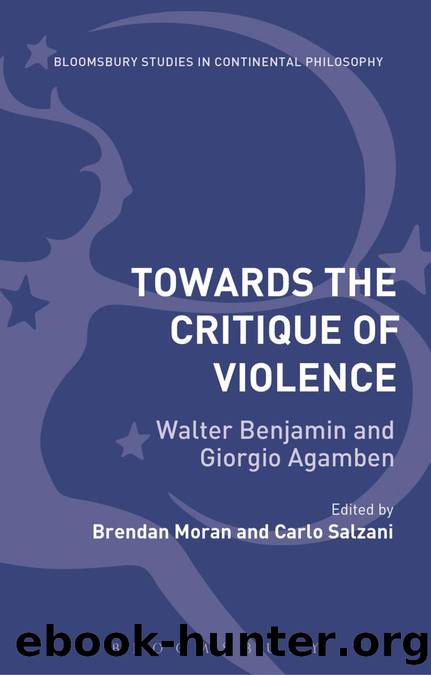Towards the Critique of Violence by Brendan Moran;Carlo Salzani;

Author:Brendan Moran;Carlo Salzani;
Language: eng
Format: epub
Tags: Walter Benjamin and Giorgio Agamben
ISBN: 9781472533494
Publisher: Bloomsbury UK
Published: 2019-11-23T00:00:00+00:00
Genealogy and critique
The account of sacrifice that Agamben presents in works like Language and Death, Homo Sacer, and The Kingdom and the Glory could be regarded as an archaeology or a genealogy tracing the concepts of law, politics and government back to their origins in sacrificial violence.7 It is clear, however, that Agamben has much grander ambitions than that. In the last paragraph of Language and Death, he writes that âa completed foundation of humanity in itself should ⦠signify the definitive elimination of the sacrificial mythogeme and of the ideas of nature and culture, of the unspeakable and the speakable, which are grounded in itâ (LD 106). Agamben even calls for the abandonment of âthe sacralization of lifeâ, which, he says, âderives from sacrificeâ (LD 106). The fact that he combines his genealogy of sacrificial violence with calls for its elimination suggests that his works are not neutral from a moral or political point of view. In fact, they are part of a critique of sacrificial violence, modelled on Benjaminâs critique of violence, which extends from Agambenâs earliest works to his most recent publications.
If Homo Sacer is to be regarded as an extension of the account of sacrifice that Agamben presents at the end of Language and Death, it can also be seen as an extension of his call for the abandonment of the doctrine of the sacredness of life. Homo Sacer makes it clear that this doctrine is the product of sacrifice. It does not cherish and protect life, as those who assert the sacredness of life often claim, but separates life from the things and relations that constitute the order of the profane world. This separation exposes life to the arbitrary violence of the same sovereign decision that made life an object of sacrifice in the first place. As we have seen in the figure of homo sacer and in the camps, life that is exposed to sovereign decision is not inviolable; on the contrary, it is abandoned to indiscriminate violence and exposed to killing without sanction. That is why Agamben contends that âthe sacredness of life, which is invoked today as an absolutely fundamental right in opposition to sovereign power, in fact originally expresses precisely both lifeâs subjection to a power over death and lifeâs irreparable exposure in the relation of abandonmentâ (HS 83). However, his objections to the doctrine of the sacredness of life do not stop with the revelation of its âsecret complicityâ with sacrificial violence. At the end of Homo Sacer, Agamben outlines the programme for what he calls âa new politicsâ, which would no longer be governed by sacrificial violence. Many of the works he has published in the years since the publication of Homo Sacer are meant to bring this new politics to life.
One alternative to the violence of sacrifice is to be found in the theological genealogy of government that Agamben undertakes in The Kingdom and the Glory. What is most important about government is its attempt to contain the violence of sovereign power.
Download
This site does not store any files on its server. We only index and link to content provided by other sites. Please contact the content providers to delete copyright contents if any and email us, we'll remove relevant links or contents immediately.
The European History Highway: A Guide to Internet Resources by Dennis A. Trinkle Scott A. Merriman(498)
The Seven Wonders of the Ancient World by Michael Denis Higgins(479)
European Security in a Global Context by Thierry Tardy(472)
European Security without the Soviet Union by Stuart Croft Phil Williams(472)
The Routledge companion to Christian ethics by D. Stephen Long Rebekah L. Miles(461)
Hudud Al-'Alam 'The Regions of the World' - a Persian Geography 372 A.H. (982 AD) by V. V. Minorsky & C. E. Bosworth(402)
Gorbachev And His Generals by William C. Green(393)
Get Real with Storytime by Julie Dietzel-Glair & Marianne Crandall Follis(391)
Tibetan Studies in Comparative Perspective by Chih-yu Shih Yu-Wen Chen(387)
Governance, Growth and Global Leadership by Espen Moe(385)
Hyperculture by Byung-Chul Han(382)
CliffsNotes on Fitzgerald's The Great Gatsby by Kate Maurer(363)
The Oxford History of the World by Fernández-Armesto Felipe;(357)
How Languages Are Learned 5th Edition by Patsy M Lightbown;Nina Spada; & Nina Spada(355)
The Egyptian Economy, 1952-2000 by Khalid Ikram(355)
Oral Poetry and Narratives from Central Arabia: The Poetry of Ad-Dindan : A Bedouin Bard in Southern Najd (Studies in Arabic Literature, Vol 17) (English and Arabic Edition) by P. M. Kupershoek P. Marcel Kurpershoek(345)
The Oxford Handbook of the Incas by Sonia Alconini(336)
Europe Contested by Harold James(323)
The Hutchinson Dictionary of Ancient and Medieval Warfare by Peter Connolly John Gillingham John Lazenby(308)
